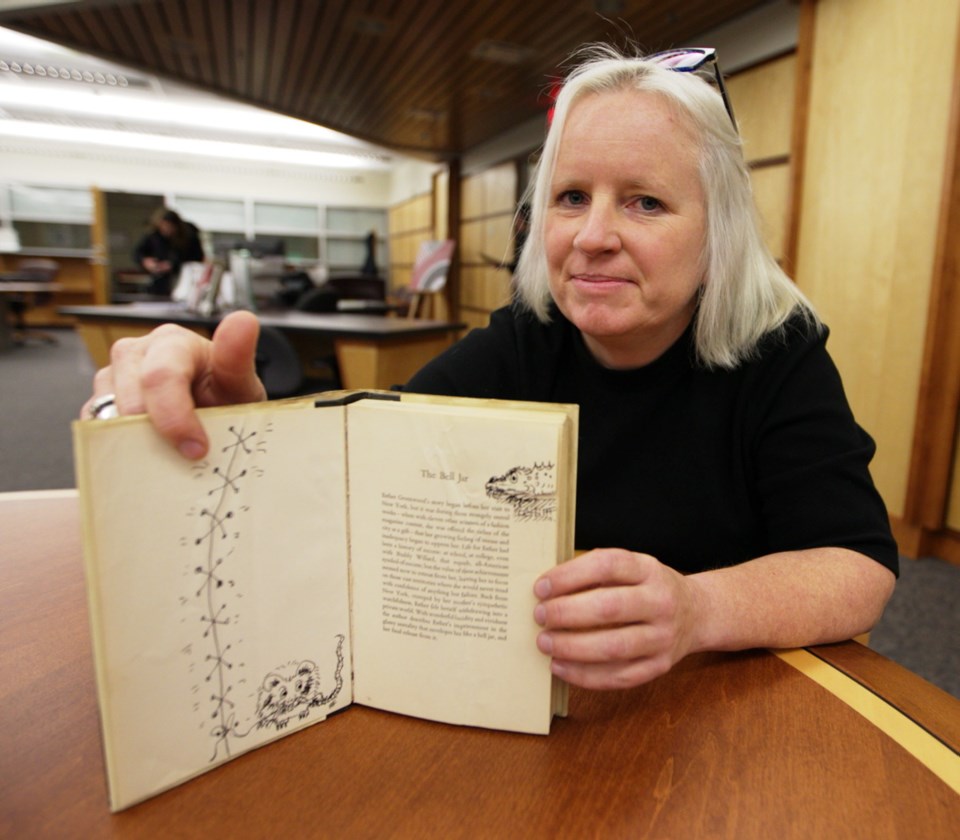A rare, first edition of Sylvia Plath’s The Bell Jar, embellished with doodles by her artist daughter, Frieda Hughes, is now with the University of Victoria’s special collections.
UVic librarians first heard of the book, for sale by a dealer in California, in July and agreed to pay the $8,500 US price to buy the 1963 volume. It will be kept in a temperature-controlled vault, but available to scholars and students.
“The book gives students a chance to engage with the materiality of the work,” said Lara Wilson, UVic director of special collections. “Students now are just increasingly alienated in our digital world from the material publication of a work.”
American poet and novelist Sylvia Plath (1932-1963) is recognized as one of the icons of 20th-century poetry in English.
Her poetry was described in a recent article for The Atlantic as “freakishly bleak” but also “invincible.” She drew upon her own life experiences of depression, anger, betrayal and suicide attempts in work also called “confessional” in style.
Plath was married to British poet Ted Hughes (1930-1998) from 1956 to 1962. They had two children, Nicholas Hughes (1962-2009) and Frieda, born in 1960, a poet and painter who lives in Wales.
The volume of The Bell Jar purchased by UVic has a crack in the front cover, and Frieda decorated the crack with a zipper motif, drew stitches on the inside cover and drew an alligator biting at a small tear on a page.
Letters written by Frieda and also purchased by UVic attest to the authenticity of the drawings and the book.
The Bell Jar was first published in the U.K. in 1963, under the pseudonym Victoria Lucas. Plath described it to her mother as a depiction of a woman undergoing a breakdown, seeing the world as through the distorting glass of a bell jar.
The UVic book is one of a print run of 500 to 1,000 volumes that closely followed on the heels of the original print run of 2,000, which was finished just months before the author’s suicide. Despite the pseudonym, most of London’s literary society knew the real author as Plath, and demand was high after her suicide.
It’s believed the UVic book passed to Frieda at some point after her brother’s suicide.
The book made its way to UVic through a digital connection.
UVic librarian, Plath scholar and poet Christine Walde is an online follower of Plath scholar and biographer Peter K. Steinberg, of Boston, who first heard of the volume for sale and mentioned it in a blog post.
Recognizing its scholastic value, Walde and Wilson brought the book to Victoria.
Steinberg, in Victoria for the book’s arrival, said the daughter’s doodles are very much in the tradition of Plath’s own approach to books. She was constantly jotting notes, questions, thoughts and doodles, almost creating a personal relationship.
He said the book will be valuable for Plath scholars, as it will not have been affected by some of the “bizarre” edits her published work has undergone since her death, in one known case deleting an entire phrase from an original sentence.
Meanwhile, Walde said, for students of Plath, this original publication carries an intact dust jacket with names of other authors printed by the same publisher, William Heinemann Ltd.
For scholars of Plath, it’s noteworthy to see her work was originally included in a literary canon of the time that includes names such as Anthony Burgess, author of the 1962 novel A Clockwork Orange, later to become a celebrated 1971 film, directed by Stanley Kubrick.
Anyone interested in the book or hearing about Sylvia Plath can attend a lecture by Steinberg today at 4:30 p.m. at UVic in Room 210 of the Mearn’s Centre for Learning in the McPherson Library.



